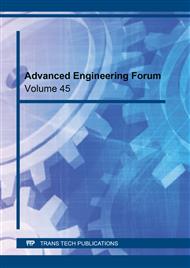[1]
S. C. Madathil, Modeling and Analysis of Remote Off-grid Microgrids, PhD, Industrial Engineering, Clemson University, Clemson, South Carolina,USA, (2017).
Google Scholar
[2]
Information on http://www .https://www.mtu-solutions.com/trmea/en/stories/technology/ electrification/successfully-disconnected.html.
Google Scholar
[3]
M. Kaur, S. Dhundhara, Y.P. Verma, and S. Chauhan, Techno‐economic analysis of photovoltaic‐biomass‐based microgrid system for reliable rural electrification, International Transactions on Electrical Energy Systems,30 (2020) 1-20,.
DOI: 10.1002/2050-7038.12347
Google Scholar
[4]
J. Ahmad, M. Imran, A. Khalid, et al., Techno economic analysis of a wind-photovoltaic-biomass hybrid renewable energy system for rural electrification: A case study of Kallar Kahar, Energy, 148 (2018) 208-234.
DOI: 10.1016/j.energy.2018.01.133
Google Scholar
[5]
G. Veilleux, T. Potisat, D. Pezim, et al.,Techno-economic analysis of microgrid projects for rural electrification: A systematic approach to the redesign of Koh Jik off-grid case study, Energy for Sustainable Development, 54 (2020) 1-13.
DOI: 10.1016/j.esd.2019.09.007
Google Scholar
[6]
M. R. Fuad, D. Octavianthy, and W. W. Purwanto, Techno-economic analysis of natural gas-fired microgrid for electricity, fresh water, and cold storage in rural area, AIP Conference Proceedings (2019) 20-28.
DOI: 10.1063/1.5095006
Google Scholar
[7]
S. You, H. Tong, J. Armin-Hoiland, Y. W. Tong, and C.-H. Wang, Techno-economic and greenhouse gas savings assessment of decentralized biomass gasification for electrifying the rural areas of Indonesia, Applied Energy, 208 (2017) 495-510.
DOI: 10.1016/j.apenergy.2017.10.001
Google Scholar
[8]
S. Mazzola, M. Astolfi, and E. Macchi, The potential role of solid biomass for rural electrification: A techno economic analysis for a hybrid microgrid in India, Applied Energy, 169 (2016) 370-383.
DOI: 10.1016/j.apenergy.2016.02.051
Google Scholar
[9]
G. Oriti, A. L. Julian, N. Anglani, and G. D. Hernandez, Novel Economic Analysis to Design the Energy Storage Control System of a Remote Islanded Microgrid, IEEE Transactions on Industry Applications, 54 (2018) 6332-6342.
DOI: 10.1109/tia.2018.2853041
Google Scholar
[10]
K. E. Garcia, Optimization of microgrids at military remote base camps, MSc, NAVAL POSTGRADUATE SCHOOL, Monterey,California USA, (2017).
Google Scholar
[11]
L. Olatomiwa, S. Mekhilef, A. S. N. Huda, and K. Sanusi, Techno-economic analysis of hybrid PV-diesel-battery and PV-wind-diesel-battery power systems for mobile BTS: the way forward for rural development, Energy Science & Engineering, 3 (2015) 271-285.
DOI: 10.1002/ese3.71
Google Scholar
[12]
J. S. Ojo, P. A. Owolawi, and A. M. Atoye, Designing a Green Power Delivery System for Base Transceiver Stations in Southwestern Nigeria, SAIEE Africa Research Journal, 110 (2019) 19-25.
DOI: 10.23919/saiee.2019.8643147
Google Scholar
[13]
S. T. Leholo, P. A. Owolawi, and K. T. Akindeji, Modelling and Optimization of Hybrid RE for Powering Remote GSM Base Station, in 2018 IEEE PES/IAS PowerAfrica, (2018) 869-874.
DOI: 10.1109/powerafrica.2018.8520994
Google Scholar
[14]
N. Kalkan, K. Bercin, O. Cangul, M. G. Morales, M. M. K. M. Saleem, I. Marji, A. Metaxa, E. Tsigkogianni, A renewable energy solution for Highfield Campus of University of Southampton, Renewable and Sustainable Energy Reviews, 15 (2011) 2940-2959.
DOI: 10.1016/j.rser.2011.02.040
Google Scholar
[15]
V. B. Hau, M. Husein, I.-Y. Chung, D.-J. Won, W. Torre, and T. Nguyen, Analyzing the impact of renewable energy incentives and parameter uncertainties on financial feasibility of a campus microgrid, Energies, 11 (2018) 2446.
DOI: 10.3390/en11092446
Google Scholar
[16]
K. S. Saritha, S. Sreedharan, and U. Nair, A generalized setup of a campus microgrid - A case study, in International Conference on Energy, Communication, Data Analytics and Soft Computing (ICECDS), Chennai, India, (2017), 2182-2188.
DOI: 10.1109/icecds.2017.8389838
Google Scholar
[17]
N. S. Savic, V. A. Katic, N. A. Katic, B. Dumnic, D. Milicevic, and Z. Corba, Techno-economic and environmental analysis of a microgrid concept in the university campus, in 2018 International Symposium on Industrial Electronics (INDEL), Banja Luka, Bosnia and Herzegovina, (2018).
DOI: 10.1109/indel.2018.8637613
Google Scholar
[18]
L. Al-Ghussain, A. Darwish Ahmad, A. M. Abubaker, and M. A. Mohamed, An integrated photovoltaic/wind/biomass and hybrid energy storage systems towards 100% renewable energy microgrids in university campuses, Sustainable Energy Technologies and Assessments, 46 (2021) 101273.
DOI: 10.1016/j.seta.2021.101273
Google Scholar
[19]
J. J. D. Nesamalar, S. Suruthi, S. C. Raja, and K. Tamilarasu, Techno-economic analysis of both on-grid and off-grid hybrid energy system with sensitivity analysis for an educational institution, Energy Conversion and Management, 239 (2021) 114188.
DOI: 10.1016/j.enconman.2021.114188
Google Scholar
[20]
P. G. Arul, V. K. Ramachandaramutthy, and R. K. Rajkumar, Control strategies for a hybrid renewable energy system: A review, Renewable and Sustainable Energy Reviews, 42 (2015) 597-608. doi: http://dx.doi.org/10.1016/j.rser.2014.10.062.
DOI: 10.1016/j.rser.2014.10.062
Google Scholar
[21]
C. Ammari, D. Belatrache, B. Touhami, and S. Makhloufi, Sizing, optimization, control and energy management of hybrid renewable energy system—A review, Energy and Built Environment, (2021).
DOI: 10.1016/j.enbenv.2021.04.002
Google Scholar
[22]
P. Gajewski and K. Pienkowski, Control of the Hybrid Renewable Energy System with Wind Turbine, Photovoltaic Panels and Battery Energy Storage, Energies, 14 (2021) 1595. doi: https://doi.org/10.3390/en14061595.
DOI: 10.3390/en14061595
Google Scholar
[23]
B. C. Phan and Y.-C. Lai, Control Strategy of a Hybrid Renewable Energy System Based on Reinforcement Learning Approach for an Isolated Microgrid, Appl. Sci., 9 (2019) 1-24. doi: http://.
DOI: 10.3390/app9194001
Google Scholar
[24]
M. H. Chung, Estimating Solar Insolation and Power Generation of Photovoltaic Systems Using Previous Day Weather Data, Advances in Civil Engineering, (2020) 1-13.
DOI: 10.1155/2020/8701368
Google Scholar
[25]
H. Tazvinga, X. Xia, and J. Zhang, Minimum cost solution of photovoltaic–diesel–battery hybrid power systems for remote consumers, Solar Energy, 96 (2013) 292-299.
DOI: 10.1016/j.solener.2013.07.030
Google Scholar
[26]
H. Tazvinga, Energy optimisation and management of off-grid hybrid power supply systems, Doctor of Philosophy, Department of Electrical, Electronic and computer engineering, University of Pretoria, Pretoria, (2015).
Google Scholar
[27]
L. Arturo Soriano, W. Yu, and J. d. J. Rubio, Modeling and Control of Wind Turbine, Mathematical Problems in Engineering, (2013) 1-13.
DOI: 10.1155/2013/982597
Google Scholar
[28]
S. Lalljith, A. G. Swanson, and A. Goudarzi, An intelligent alternating current-optimal power flow for reduction of pollutant gases with incorporation of variable generation resources, Journal of Energy in Southern Africa, 31 (2020) 40-61.
DOI: 10.17159/2413-3051/2020/v31i1a7008
Google Scholar
[29]
M. H. H. Albadi, On Techno-Economic Evaluation of Wind-Based DG, Doctor of Philosophy, Electrical and Computer Engineering, University of Waterloo, Waterloo, Ontario, Canada, (2010).
Google Scholar


